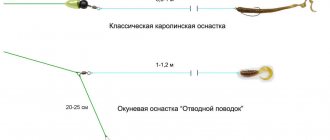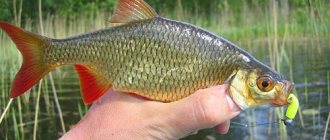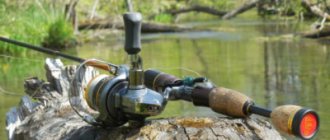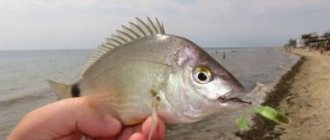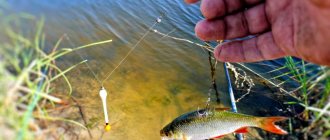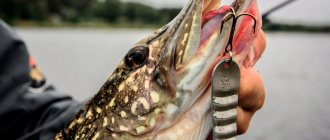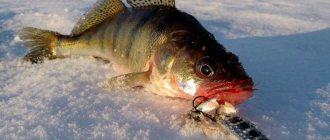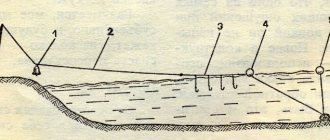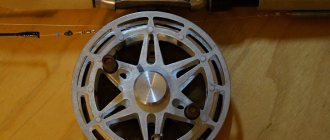A bottom overgrown with vegetation, abrasive sand, shell rock and stone, a hole filled with snags, muddy litter, branches and leaves that have fallen to the bottom are all favorite sites for predatory fish. But bad luck, getting it out of there with a regular jig is difficult, expensive and nerve-wracking.
In such difficult and at the same time promising places for fishing, it is important to use Carolina rig (Carolina rig, carolina rig), which refers to those types of spaced installation that will pass fire, water and copper pipes and is inexpensive, and even a beginner can install it . The Caroline is rightfully considered one of the most passable rigs.
In terms of cross-country ability, only the Texas rig can compete with the Carolina rig, but installation, conditions for optimal use, as well as the advantages and disadvantages of these equipment are different.
We can say that Carolina Rig = Texas Rig + leash.
Spaced rigs - you can clearly see the difference in the installation of the Carolina and Texas ones
There is no ideal bait and equipment for fishing, but there is one that is correctly selected for certain circumstances.
What does it look like (with photos and videos underwater) and what can the Carolina rig do?
Carolina rig is a subspecies of the classic Texas rig, but with some modifications that affect the features of using this type of rig, as well as the behavior and animation of the bait.
It is a spaced jig rig, where between the sliding sinker and the bait on the offset there is a fluorocarbon leader attached to the main braid through a swivel.

Texas and Carolina
What classic spaced-out rigs look like underwater - Tokio Rig, Texas Rig, CarolinaRig and a diverting leash:
Among the advantages of Carolina it is worth noting:
- Effective against passive fish , due to the fact that you can fish a promising water area with slow types of animation with long pauses and lazy dragging, practically forcing a generally unhungry predator to catch it because of its anger at uninvited guests - worms or fry.
- High permeability among stones, pebbles, shells, underwater vegetation and along sandy ridges . But for snags it is better to use Texas.
- Can be fished at any adequate depth . The size of the load does not in any way interfere with the predator’s bite. Due to the fact that it is sliding and distanced from the bait, the fish does not feel resistance when biting.
- From the previous point, the next one is that when using edible rubber, you can give the fish time to swallow the bait thoroughly - pause for a bite. This is possible because the predator does not sense the trick.
- Easy to install . A little more difficult than Texas, but still easier than other spacing.
Installation of Carolina rigging: which bullets and beads to choose, how to tie Carolina correctly
What is needed for making
To make it you will need spinning tackle (requirements for it are below). And also: weights of different weights, fluorocarbon in different unwindings, offset hooks, beads, swivels and a little knowledge.
How to choose a sinker
The weight for the Carolina rig is almost always a sliding bullet and only in the absence of one is an olive or an eared one.
According to the classics, foreign colleagues use bronze, brass, and tungsten as materials for bullets. They are louder when they hit a bead, which supposedly provides additional motivation for the fish to grab.
There is also an opinion that due to the fact that they do not dent, unlike lead, they get stuck less among stones, but this is a very controversial fact that has not been verified in practice. We found no such studies.
Our fishermen are not so rich and not such aesthetes, and therefore the good old lead is in favor.
The weight is selected exclusively in the same way as in classic jig fishing based on the depth of the reservoir, the strength of the current and the required casting distance.
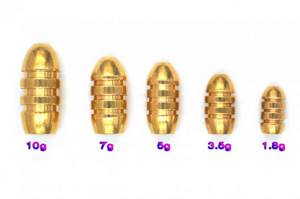
Bronze bullets are very high quality and beautiful, but the price is steep - the price for a set is from 5 USD and above
By weight of bullets of the same size: brass (bronze plus minus)<lead<tungsten. Therefore, we would advise using tungsten in most cases, but only if there is such an opportunity.
How to choose a hook
In 99 percent of cases, an offset hook is used, since the Carolina hook is used in difficult conditions, and therefore there is no point in using regular hooks.
The size, height, shape is dictated by the baits used. You always need to have a set of offsets for different spinning conditions.
How to choose a bead(s)
Beads are needed to protect the nodal connections from the aggressive effects of a load sliding along the fluor. The bead should not splinter when hit by a bullet, and ideally, it should make a clicking noise when impacted by a weight.
Some colleagues consider the acoustic effect to be insignificant, or even far-fetched, but other experts, for example, the Shcherbakov brothers, have a different opinion and recommend using sounding beads made of brass and other sonorous materials in combination with a weight of the same composition.
How to choose a swivel
The swivel must first of all fit into the general outline of the tackle, that is, correspond to all its other parts. Don't be too small or too big. It is also important that it is of high quality and works well even on the slowest retrieves, otherwise twisting of the line cannot be avoided.
It is worth paying attention to the swivels on bearings!
How to choose the leash material, its length and thickness
Fishing takes place in an aggressive environment, therefore, for catching pike perch, perch and other predatory fish, in addition to pike, we use wear-resistant fluorocarbon; for catfish, flexible leader material is mandatory.
The length and thickness are selected based on the type and activity/passivity of the fish, as well as fishing conditions.
How to assemble the equipment installation
When installing the Carolina rig, it is important to take into account two nuances.
The first is that the leash should be made exclusively of fluorocarbon, due to the fact that you have to fish in difficult conditions, when the final part of the equipment is constantly exposed to the abrasive effects of sand, shells, stones, gravel, snags, etc. And it is fluor that is best suited for such conditions, while braid quickly becomes unusable.
The second is that the bullet-shaped sinker (or olive) constantly slides along the main fishing line, which also has an extremely bad effect on the cord, and this part of the equipment should also be fluor-based.
Option two:
- First. The main line is also fluorocarbon with a thicker diameter than the Carolina leader.
- Second. If braid is used as a base, then you need to tie up an additional part of fluorine, along which the weight will slide .
Classic Carolina rig
The first option is the classic one, when the weight is located on the main line.
Some fishermen do this installation with braid as a base, but we do not recommend it for the reasons stated above.
So, fluor 0.3-0.4 mm is used as a base. We pass a bullet-shaped sinker of the required weight with the nose to the tip of the rod.
Then we select the bead so that it fits “comfortably” into the recess of the bullet. We take a high-quality swivel that is commensurate with the entire equipment and tie it after the bead with one of the clinch, reverse clinch, double clinch, or palomar knots.
A fluor leash 0.05 mm thinner than the main one is tied to another part of the swivel through the same knot. That is, approximately 0.22-0.3 mm. The length of the leash is selected experimentally and depends on the activity of the fish, the speed of the current, the depth of fishing and the possibility of casting.
I have an opinion! Many hardcore spinning anglers recommend using a leash of at least 1 meter for Carolina spinning rods. Especially if the fish is extremely passive. There is a reason to listen, since the opinion is very widespread and is expressed by experienced athletes and simply practitioners.
In general, regarding the length of the leash, you should adhere to these not dogmas, but rules:
- the more passive the fish, the longer the leash and vice versa;
- the stronger the current speed, the longer the leash and vice versa;
- the deeper the water area, the longer the leash (and the larger the sinker);
- a long leash reduces the possibilities of casting, especially when fishing from overgrown banks, and this also needs to be taken into account.
An offset hook is tied to the second part of the leash and then the bait is attached.

Ready-made classic Carolina montage
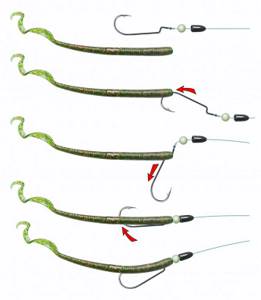
Installation of a worm (driven twister) on an offset hook
We select the length of the offset hook according to the size of the bait, the width according to the type of silicone - the more propulsive it is, the lower the offset and, vice versa. It is important that the tip of the hook is hidden in the back of the bait, but at the same time, when biting, it is easily squeezed out.
Improved Carolina rig on a two-piece leader
This type of installation is used by avid and experienced spinning anglers if the main fishing line is braided.
In this case, we make two cuts of fluor, 50-60 cm each. We tie the two resulting sections to the swivel at different ends. Knots - clinch, palomar.
We put a bead on one segment, then a bullet, with a notch to the bead and another smaller bead on top. This part (pictured below on the right) will later be attached to the main cord through a knotless cord, a carrot knot, or through another swivel.
An offset hook is tied to the second part of the two-part leash and the bait is attached - everything is as in the method described above.
As a result, we get the following installation:
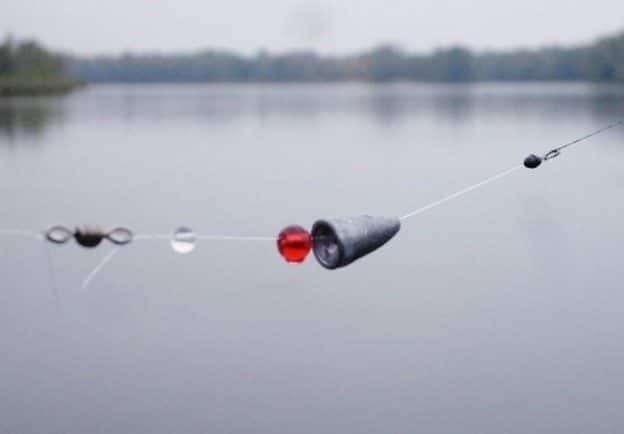
Caroline on a two-part leash
Two beads work as bumpers on both sides so that the knots do not break either to the swivel or to the knot that secures the main wattle and the leading part.
The weight slides along the flurry, the leash is of sufficient length.
The downside is that there are more fittings, which means there is a greater chance of breakage, plus it is not the best option for fishing in mud and snot algae, which tend to stick to all the equipment.
Mounting options for Carolina rigs when fishing for different predators
Carolina rigs for pike should contain a leader made of soft leader materials in the final part. Especially if the fishing for this predator is targeted. It is knitted in the same way, only at the end part a leash of up to 30-40 cm is placed from a soft one! (this is important) material.
Heavier weights and larger baits are also usually used, which is determined by the habits and places that the pike chooses for hunting.
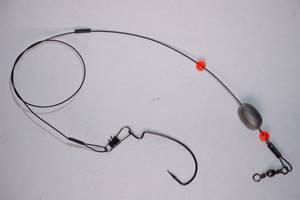
When fishing for perch , especially passive ones, use the longest leashes of a meter or more. A diameter of 0.2-0.25 mm is almost always sufficient. Baits in 2-3 inches on appropriate hooks.
If the goal is pike perch , then when installing the Carolina equipment, it is worth taking into account the place in which the fishing will take place. In general, the leash used is shorter than for perch fishing, but thicker. Diameter 0.25-0.35 mm. The baits are also larger.
Making Carolina equipment step by step is clearly shown in the video:
Equipment elements
Elements of Texas equipment have changed a little for improvement in our time. The basis of such equipment consists of:
- Lure - any soft material, the usual ratio of width to length is 1: 12, without protruding elements. Any color, from natural to acidic.
- Hook – offset, with a straight or wide bend of the fore-end;
- Bead (damper) - located between the sinker and the hook, to protect the hook attachment point.
- Bullet weight - for wiring in hard-to-reach places. It is necessary to select a load for equipment depending on the speed of the current.
Elements of Carolina equipment:
- Sinker - can be drop-shaped, in the shape of an olive or a bullet, it must have a through longitudinal hole. The material is brass or bronze; lead is also suitable for fishing in our reservoirs.
- The leash is fluorocarbon, which is very durable and almost invisible in the water, but to reduce the cost of the element, you can use a leash made of good monofilament fishing line:
- Bead and swivel - the swivel must be strong, it performs the function of anti-twisting of the gear, it is taken in very small sizes so that it does not catch on the algae;
- Bead – protects the hook knot and attracts fish with ringing clicks;
- The hook is offset, the size depends on the size of the bait used.
With the help of Carolina equipment, it is possible to fish with natural baits using double and triple hooks. Having solved the problem of bait activity in the Carolina rig, they worsened the quality of fishing in hard-to-reach places
In what conditions is CarolinaRig installation especially good?
Carolina tackle is used when catching a passive and inhibited predator. In the middle latitudes of the CIS and the Russian Federation it performs well in early spring and summer, as well as throughout the year at points where it is necessary to fish the water area as slowly and accurately as possible.
For example, such places include holes and edges littered with debris when fishing for pike, riffles and places near them overgrown with grass and small algae when fishing for perch, gravel and rocky places where pike perch often hunt.
Due to the fact that this is a classic non-hooking with an emphasis on animation - dragging along the bottom, it works great in difficult conditions of an aggressive and overgrown bottom. Can be used among reeds, water lilies, on pebbles and sand.
What baits are used
For fishing with Carolina, worms, slugs, crustaceans, nymphs, vibrotails and twisters are used. Often - driven, as more passable and almost always edible.
Many fishermen prefer passive types of baits, due to the fact that the wiring technique involves constant impact on the bait with a rod and reel - dragging, tossing, light twitching...
It can be used as a regular sinking silicone, then it will drag along the bottom or jump, like a jig on a step, if the angler so desires. Or floating silicone, then it will float at some distance from the bottom (pelagic), animated following the actions of the spinning rod.
It is important that the bait is made of durable silicone - in the Carolinas the bait suffers a lot, especially its bow, which is often torn by the offset when a fish bites or hits rocks and snags.
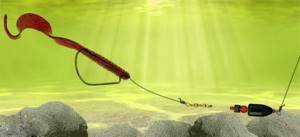
Fishing technique
The basic technique for retrieving a Carolina rig is as follows: after casting, the rig is allowed to fall to the bottom, and then a slow retrieve with pauses is started. At the same time, they constantly play along with the tip of the spinning rod. When fishing in snags, the angler tactilely records the passage of branches and twigs of flooded trees with a sinker and, taking into account the length of the leash, allows the bait to slowly fall into the gaps among the snags.
It is very effective to use Carolina rigs when placing them between bushes of bottom plants. Predators tend to hide in such bushes and when the bait passes nearby they can attack it. Sometimes even fishing can bring good results, especially when fishing on a clear bottom.
Fishing with a Carolina rig is quite leisurely, with elements of contemplation, so fans of active spinning fishing methods such as jig-spinning and twitching often neglect it. Bites when fishing with a Carolina rig can be expressed in different ways. Don't expect any blows. If the fish is serious, it will be a jerk or a powerful pull. With a weak bite, the bite is felt as a slight twitching or tingling, especially perch is prone to such bites.
How to fish with a Carolina rig: casting, retrieving technique, fishing on the river and in calm water
The Carolina rig is especially effective on reservoirs without current and in slow currents. It is in such conditions that Carolina shows itself at its best, allowing you to animate the bait as lazily as possible, dragging it along the bottom and playing along with the tip of the rod.
In holes and their entrances, on deep slopes, on edges, sharp and smooth changes in depth, you can work the bottom efficiently if you choose the right load. In such places, pike and large perch often lie in ambush behind underwater vegetation or snags.
For pike, the basic wiring of the Carolina fish works - uniform dragging with pauses and accelerations. Perch responds well to all sorts of tweaked animation motifs.
And, of course, when fishing for pike perch and perch on a rocky pebble bottom strewn with shell rock, the Carolina rig has no equal. Animation - uniform dragging along the bottom with pauses, a wavy step, uniform dragging with the tip of the form.
On a current, unlike a regular jig, a good result is achieved by casting across and into the current, so that the bait is dragged toward itself. The weight of the bullet is selected in such a way that when retrieving the bait, it will not be squeezed to the surface, but will go along the bottom.
It should be noted that in strong currents it will be more effective to use a diversion leash or texas.
Catching perch with a Carolina rig:
The best lures for a retractable leash
With this method of fishing, various options work.
Twister
Choose soft, cylindrical specimens with a thin or voluminous body. Material: high quality silicone. The main element - the elastic tail - will attract prey and increase the chances of catching.
Specific vibrations cause an aggressive reaction of the predator and a desire to attack the bait. Twister is made from standard and edible silicone, to which attractants, amino acids, and flavored salts are added. Their smell and taste additionally attract fish.
Slug, or “slug”, “worm”
A class of passive silicone baits for various types of fishing. Outwardly, they resemble living creatures and have an elongated shape. To attract predators, manufacturers use especially soft rubber and specific odors.
Spinner
The pinwheel is the simplest catchable bait. It is universal and does not require fancy fishing techniques or tricky garters. The product has an oval petal, which is located at an angle of 45°. This helps to fish both in the current and in calm water.
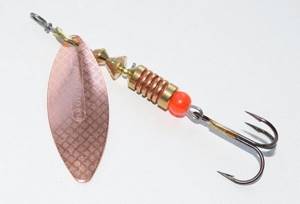
All predators of the ichthyfauna become victims of the spinner.
Other baits
Prey is caught using suspenders. A rational choice would be floating wobblers. The Moscow rig often works with live bait on the hook.
What gear is needed?
The gear is selected taking into account the fact that this is, albeit non-standard, but still jig fishing.
Form
This means that you need the most clear and responsive form, which reacts sensitively and transmits all the movements of the fisherman towards the bait and all the movements of the bait and fish bites in the opposite direction. Build - fast. The test is selected based on standard fishing conditions in your region. In most cases, two forms are enough to cover the entire test range. 2-15 and 5-30 grams. For those who fish in large reservoirs and rivers, a more powerful blank with a dough weight of up to 60 grams and higher is needed.
The length is selected according to anatomical data and fishing conditions. Station wagon 2.4-2.7 meters.
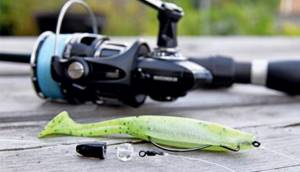
Reel and cord
If braid is used as a base, we recommend using a 2000-2500 Shimano spinning reel with high-quality cord laying and without dropping loops on aggressive types of animation. The diameter of the main braid is 0.12-0.18 mm.
If the basis is flurry, then only a multiplier. Meat grinders with thin fluor diameters (and most often used with a diameter of 0.22-0.35) work mediocrely, loops often overlap and drop off.
Beautiful Carolina rig - is it a panacea? Not really. Number one choice for jiggers? No again. Carolina is only a tool that, in skillful and understanding hands, under certain conditions, can come to the fore, leaving behind the classic jig, lead-eared rigs and other methods with which spinning anglers try to deceive an increasingly sophisticated predator.
Which reel to choose for perch fishing?
The reel requires even higher requirements. In addition to the absence of backlash, dropping loops and a good clutch, the meat grinder should have a higher gear ratio, for example, 6:2:1, plus smooth running and smooth winding.
I opt for Daiva and Shimano . Both companies produce very elegant models that have long been loved by ultralight lovers, the Luvias , Frames , this is from Daiwa, and Naschi and Ultegra from Shimano are especially good. I have both, but I use these reels on different spinning rods.
The reel must form a single whole with the spinning rod, an incredible balance is required, only then the spinning rod + braid and the reel of the right size will be the embodiment of absolute balance. Fishing with balanced light tackle is not only convenient, but also tactful and visually pleasing.
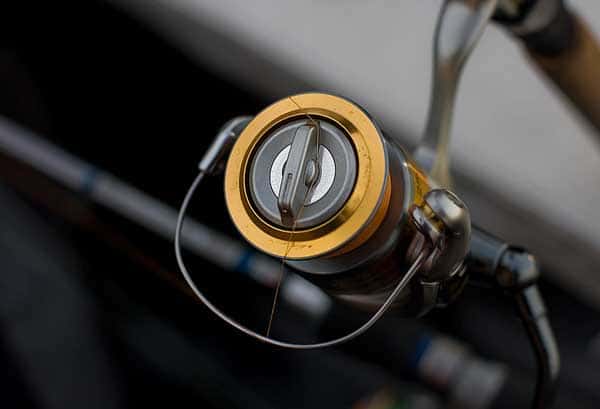
3 ways to improve your fish bite!
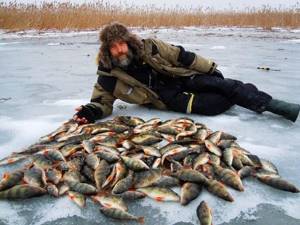
Over 15 years of active fishing, I have found many ways to improve the bite, and here are the most effective:
1. Bite activator . This pheromone additive attracts fish most strongly in cold and warm water. The Fish Hungry bite activator has proven itself to be excellent - Read more…
2. Tackle with increased sensitivity . You should first familiarize yourself with the features of using a particular type.
3. Pheromone baits . They attract the attention of fish, stimulate hunger and cause a schooling reflex, which allows you to collect a lot of fish in one place.
You can get the rest of the secrets of successful fishing for free by reading my other materials on the site.
3 ways to improve your fish bite!
Over 15 years of active fishing, I have found many ways to improve the bite, and here are the most effective:
1. Bite activator . This pheromone additive attracts fish most strongly in cold and warm water. The Fish Hungry bite activator has proven itself to be excellent - Read more…
2. Tackle with increased sensitivity . You should first familiarize yourself with the features of using a particular type.
3. Pheromone baits . They attract the attention of fish, stimulate hunger and cause a schooling reflex, which allows you to collect a lot of fish in one place.
You can get the rest of the secrets of successful fishing for free by reading my other materials on the site.
